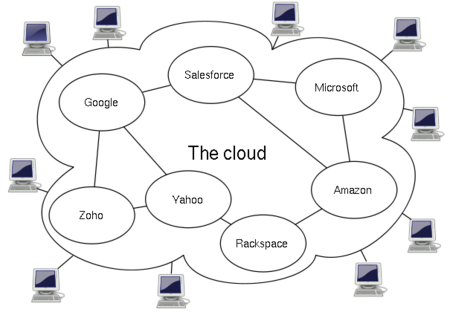Difference between revisions of "Cloud computing"
| Line 6: | Line 6: | ||
Let me tell you what that really means. Let me break out some of the keywords here. | Let me tell you what that really means. Let me break out some of the keywords here. | ||
| − | + | '''Service-based'''. First of all, the cloud is service-based. <membersonly> It is like electricity. As consumers, electricity is a service to us. We do not have to worry about the lines running through the street or how the electricity gets to our house. We just worry about flipping the switch at the right time. That is the service: it is there for us when we want to flip the switch at the right time. This is different from other kinds of software where we buy the box and we have to worry about installing and maintaining it. We have to support the entire infrastructure that goes into keeping that piece of software running. With cloud-based software, they are responsible for making sure that it runs, that it is on a server, that it is backed up, and that you can get access. All you have to do is log in and use it. That is a really big implication for nonprofits. | |
| − | |||
| − | '''Service-based'''. First of all, the cloud is service-based. It is like electricity. As consumers, electricity is a service to us. We do not have to worry about the lines running through the street or how the electricity gets to our house. We just worry about flipping the switch at the right time. That is the service: it is there for us when we want to flip the switch at the right time. This is different from other kinds of software where we buy the box and we have to worry about installing and maintaining it. We have to support the entire infrastructure that goes into keeping that piece of software running. With cloud-based software, they are responsible for making sure that it runs, that it is on a server, that it is backed up, and that you can get access. All you have to do is log in and use it. That is a really big implication for nonprofits. | ||
'''Scalable and elastic'''. The second thing is that it is scalable and elastic. What this means for us as nonprofits, is that cloud providers can add lots of capacity really quickly, or scale up; scalable. When that thing hits and you are a welfare organization and an oil spill happens and you are suddenly cleaning up four hundred pounds of pelicans a day, you have the capacity now to enter in five times the number of records you used to enter into your database. Your website can handle five times the traffic it used to because your provider can see that your traffic is going up, your use is going up, and allow you more usage. It is elastic in a sense that when that need goes away, it can shrink back down. | '''Scalable and elastic'''. The second thing is that it is scalable and elastic. What this means for us as nonprofits, is that cloud providers can add lots of capacity really quickly, or scale up; scalable. When that thing hits and you are a welfare organization and an oil spill happens and you are suddenly cleaning up four hundred pounds of pelicans a day, you have the capacity now to enter in five times the number of records you used to enter into your database. Your website can handle five times the traffic it used to because your provider can see that your traffic is going up, your use is going up, and allow you more usage. It is elastic in a sense that when that need goes away, it can shrink back down. | ||
Latest revision as of 19:46, 19 November 2010
Could computing is an Internet-based style of computing, whereby shared resources, software, and information are provided to computers and other devices on demand. Cloud computing customers generally do not own the physical infrastructure, instead avoiding capital expenditure by renting usage from a third-party provider. They consume resources as a service and pay only for resources that they use, similar to the use of the electricity grid. For those of you that are using such tools as Google Apps, Salesforce, Facebook, and Office Live, you are using the cloud.
Gartner, Inc. defines cloud computing as “a style of computing in which scalable and elastic IT-enabled capabilities are delivered as a service to external customers using Internet technologies.”
Let me tell you what that really means. Let me break out some of the keywords here.
Service-based. First of all, the cloud is service-based.
